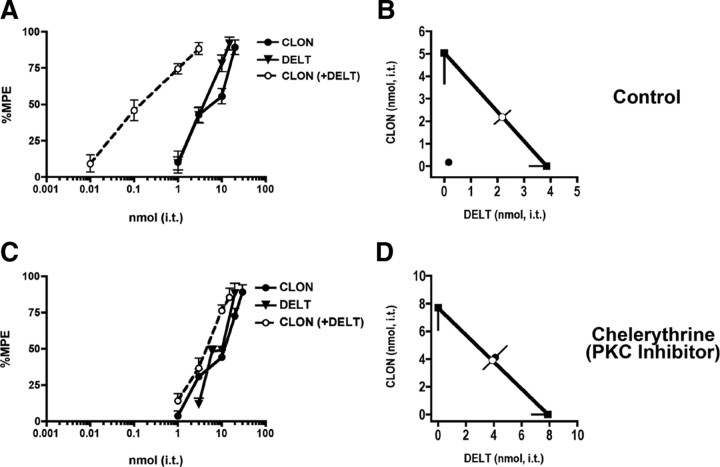Figure 2.
Coadministration of DELT and CLON is synergistic in the tail flick test. A, Nociceptive thermal responses were challenged by intrathecal administration of DELT, CLON, and their combination. DELT (filled triangles) and CLON (filled circles) inhibited the behavior in a dose-dependent manner with similar potency and efficacy. When both DELT and CLON were coadministered at a constant dose ratio of 1:1 (open circles), the resulting potency was ∼30-fold higher than either drug given alone, suggesting that the interaction was synergistic. Error bars represent mean ± SEM for each dose point (n = 6 animals/dose). B, Isobolographic analysis of the data in Figure 1A. The y-intercept represents the CLON ED50 (5 nmol; 95% CI = 3.6–6.4), and the x-intercept represents the DELT ED50 (3.9 nmol; 95% CI = 3.2–4.5) when each was administered alone. The heavy line connecting the intercepts is the theoretical additive line and the open circle represents the theoretical additive combined ED50. Coordinates for drug combinations falling below this line and outside the confidence limits indicate a synergistic interaction. When the two compounds were coadministered at a 1:1 dose ratio, the resultant ED50 (closed circle) (0.17 nmol; 95% CI = 0.11–0.23) of DELT in the presence of CLON fell well below the additive line, indicating that the interaction was synergistic. Error bars parallel to each axis represent the lower 95% CI for each compound given alone. The error bars on the combined dose points represent the upper and lower 95% CIs. C, Coadministration of DELT and CLON show additivity in the presence of the PKC inhibitor chelerythrine. Nociceptive thermal responses were challenged by intrathecal administration of DELT, CLON, and their combination in the presence of an inhibitor of PKC. DELT (filled triangles) and CLON (filled circles) inhibited the responses in a dose-dependent manner with similar potency and efficacy. Coadministration of DELT and CLON at a 1:1 dose ratio (open circles) was ∼1.9-fold more potent than either drug given alone, compared with ∼30-fold potency shift in the absence of chelerythrine (see Fig. 1A). Error bars represent mean ± SEM for each dose point (n = 6 animals/dose). D, Isobolographic analysis was applied to the data in Figure 1C. The y-intercept represents the ED50 (7.7 nmol; 95% CI = 6.1–9.3) for CLON, and the x-intercept represents the ED50 (7.9 nmol; 95% CI = 6.8–9.0) for DELT when each was administered alone. Coadministration at a 1:1 dose ratio resulted in an ED50 (closed circle) (4.1 nmol; 95% CI = 3.2–5.0) for DELT in the presence of CLON that fell on the theoretical additive line, indicating a strictly additive interaction in the presence of the PKC inhibitor.

